The owner of Toby Carvery has apologised for ‘all the upset caused’ after they felled an ancient oak tree beloved by the local community, as the pub chain faces a £1million legal bill over the ordeal.
The ancient oak tree, which once stood tall in Whitewebbs Park, in Enfield, north London, was felled on April 3.
Pub chain Mitchells & Butlers has admitted its contractors cut down the tree, near one of its Toby Carvery restaurants, after acting on the advice of employed tree experts who assessed it as dying and a risk to the public.
But Enfield Council, which leases the land to Mitchells and Butlers, has since revealed it found the tree was healthy and posed no risk during an inspection in December 2024.
The council, which said it was ‘outraged’ by the felling’, says it will be pursuing legal action over the tree which has been valued at £1million, The Telegraph reports.
The CEO of Mitchells & Butlers has today apologised in a letter to residents, seen by the BBC, which said: ‘Clearly the felling of a beautiful old tree is a very emotive subject and is not something any of us would undertake lightly. I can only apologise for all the upset that it has caused.’
He added: ‘In this instance, one of our team acted in good faith in response to expert advice and authorised the work to be done.
‘However, I would totally accept that this was an exceptional circumstance, and as part of our review, we have already concluded that we need to tighten our protocols to ensure that if something like this were to ever happen again, that we could still protect our guests, team members and/or general wider public from harm but have time for a fuller consultation.’
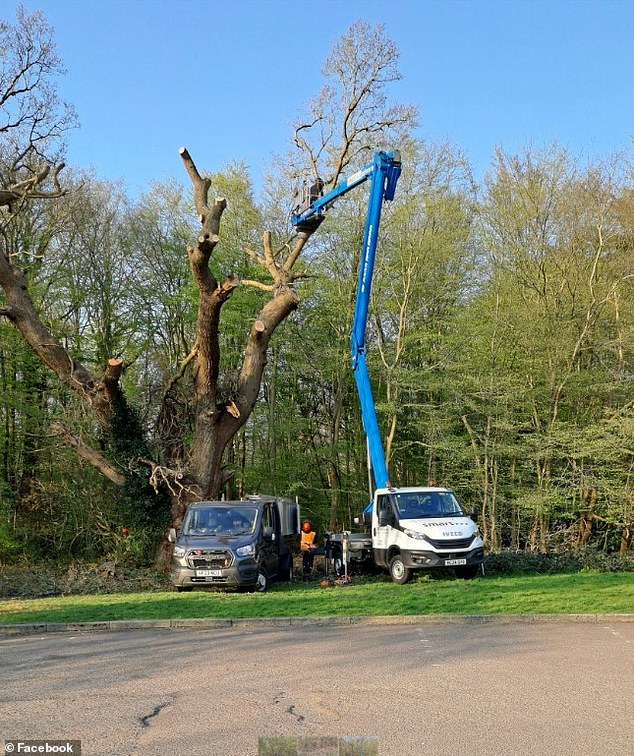
The ancient oak tree (pictured), located near a Toby Carvery pub in Whitewebbs Park, in Enfield, north London, was felled on April 3
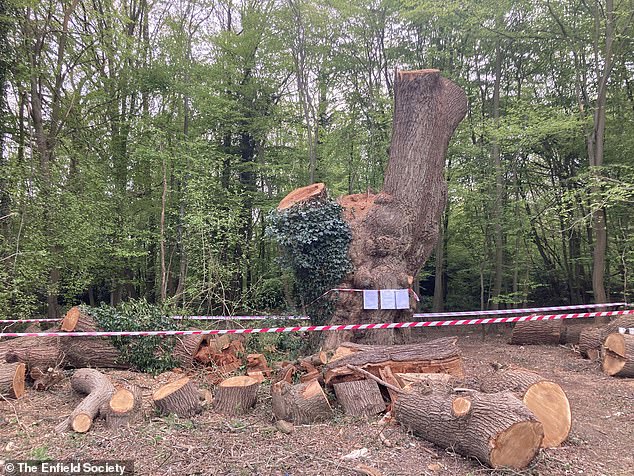
The tree, which is believed to have been felled on April 3, was only discovered by Enfield Council workers last week in Whitewebbs Park surrounded by its severed branches and trunk
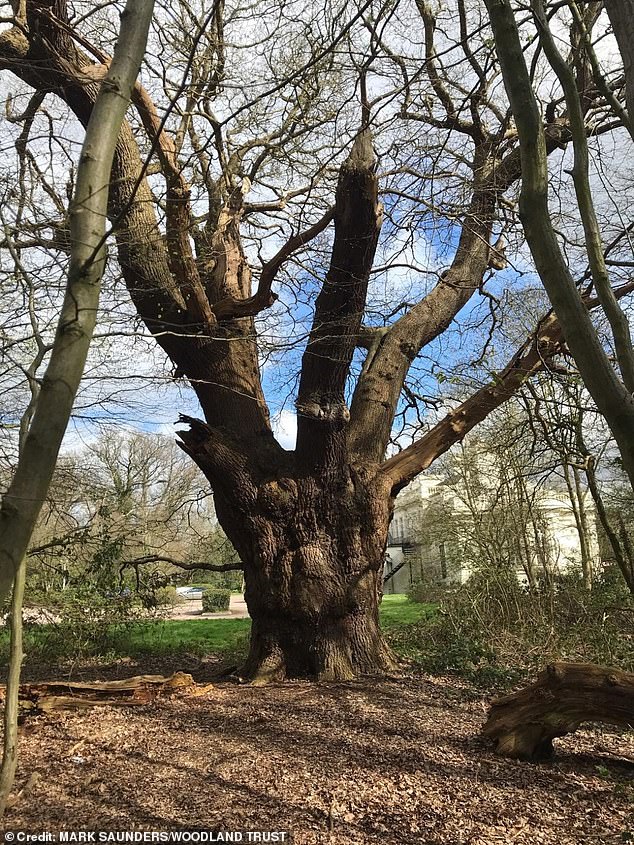
The oak tree was described as ‘one of Enfield’s most iconic trees’ before it was chopped down
The felling of the tree has been compared to that of the landmark Sycamore Gap tree next to Hadrian’s Wall in Northumberland. The iconic tree, which featured in the 1991 film Robin Hood: Prince of Thieves, was valued at more than £620,000.
Ergin Erbil, leader of Enfield Council, said on Wednesday: ‘I am outraged that the leaseholder has cut down this beautiful, ancient, oak tree without seeking any permissions or advice from Enfield Council.
‘This tree would have been home to countless wildlife, fungi, and pollinators. This tree is a part of our ecological and cultural heritage.’
The council previously reported the matter to the Metropolitan Police but the force is treating the felling as a civil matter.
Mr Erbil said the council will continue to take ‘appropriate legal action’ and will report any criminal activity found during its investigation to the police.
It also believes the firm has broken the terms of its lease to maintain and protect the existing landscape, Mr Erbil added.
‘The tree was the oldest one on site and cutting it down seems to be a clear breach of this condition,’ he said.
The Enfield oak was worth £1million, according to tree valuer Russell Miller, who made his estimate using the Capital Asset Value for Amenity Trees system.
Environmental campaigners and locals have decried the felling as ‘devastating’ and compared it to the felling of the Sycamore Gap tree in 2023.
Mr Miller said it was ‘much older and much more valuable’ than the Sycampore Gap tree.
He told the BBC: ‘This tree is designated… as an irreplaceable habitat because it’s got decay features and habitats within it that you cannot replace within hundreds of years.
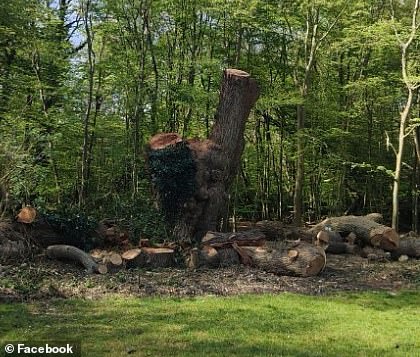
The council previously reported the matter to the Metropolitan Police but the force is treating the felling as a civil matter
‘In addition to the sorts of species that people are familiar with, like bats and owls that live in these trees, you’ve got thousands of species of invertebrate.
‘You’ve got lots of different niches for lots of different species inside the tree, and that’s why they’re so special.’
The oak was believed to be between 450 and 500 years, according to the Woodland Trust.
Ed Allnutt, an Enfield resident and secretary of the Guardians of Whitewebbs group, is organising a petition calling for a full investigation of the matter, which has been signed by more than 1,500 people.
‘This was a beloved ancient tree,’ he said. ‘With a 6.1 metre circumference, it was one of only 60 similarly ancient English oak trees in the whole of London.
‘It was an irreplaceable habitat for hundreds of species, and was at least 300 years old.’
Green groups have said there needs to be greater protections and enforcement for England’s ancient trees.
John Deakin, head of trees & Woodland at the National Trust, said: ‘Older trees are refuges for a huge variety of species from the smallest mosses and lichens and beetles to bats and a wide variety of birds.
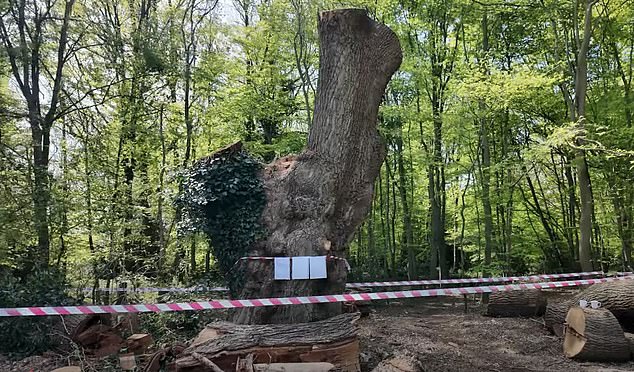
The tree felling is believed to have occurred on April 3, but it was not discovered until last week

Enfield Council, which said it was ‘outraged’ by the felling’, says it will be pursuing legal action over the tree which has been valued at £1million
‘Many trees in our care, such as the 2,500-year-old Ankerwycke yew at Runnymede and the Old Man of Calke – a 1,000-year oak tree at Calke Abbey in Derbyshire, also have a huge, cultural significance too.’
‘There is some level of protection in the national planning policy framework, but it needs greater enforcement.
‘It is also therefore crucial that the Government addresses concerns about the Planning and Infrastructure Bill currently before Parliament, so that protections for important habitats and natural features, such as ancient trees – which are irreplaceable – aren’t undermined’.
A spokesperson for Mitchells & Butlers said: ‘The tree was cut back after we were advised by our specialist arboriculture contractors that it caused a potential health and safety risk.
‘This was an important action to protect our employees and guests as well as the wider general public, to whom we have a duty of care.
‘We took necessary measures to ensure any legal requirements were met. We are grateful to our specialist arboriculture contractors for warning us of this potential health and safety risk, allowing us to act swiftly to address it.’







